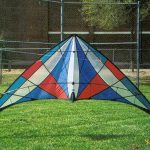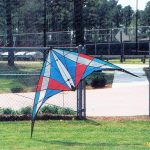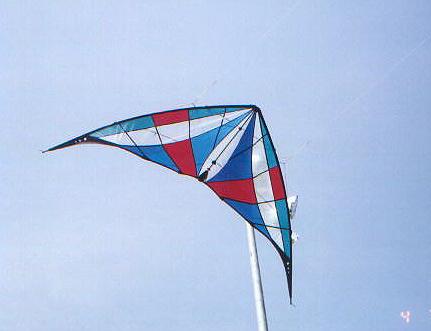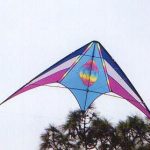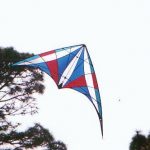 Prophecy
Prophecy
Manufacturer: Prism Designs
Wingspan: 8 feet
Height: 54.5 inches
Wind Range: 2-20 mph
Est. Street Price: $350
The Prophecy is one of three highly anticipated new kites from Prism this year. The look of the kite is very similar to that of the Illusion, but the size is not. The Prophecy is a full 8-foot kite and also tall, at 54.5 inches. Compared to most modern sport kites it is a monster but with an elegant look and some noteworthy new features.
This large and expensive kite comes well protected. The Prophecy has a padded bag that will hold at least two kites; it also has a sleeve to hold spars. Inside the padded bag the kite is in a regular nylon bag. As usual for Prism, the Prophecy comes with a very helpful field card. Also included are swatches of repair tape should you get any holes in the sail. The instructions in the field card are very good and help with assembly.
The Prophecy is constructed to the same high quality standards as all of Prism’s kites. The sail is made up of ½ oz ripstop polyester, mylar laminates, and a dacron material on the wing tips. The seams are taped and sewn down with a strip of black insignia tape on the front of the kites. The insignia tape outlines all 17 panels and makes it appear that there are even more panels. It also gives a very sharp, bold look to the kite. The Prophecy is well reinforced, with webbing at the nose, dacron leading edges, dacron at the T and standoff connections points on the sail, and a patch of insignia tape at the upper spreader spine crossing. The kite is also outfitted with a Velcro release spine.
Once the kite is assembled you see what a monster it is. The Prophecy has a deep sail that is held tight by three standoffs on each side. The spars are connected with APA fittings and Prism’s T connector. They chose to use five different kinds of SkyShark rods to frame the kite. To help increase the durability the lower spreaders have been beefed up at the T end, as have the lower leading edge at the spreader connector. There is a tension line to insure quiet flight as well.
The Prophecy is armed with a few new features. First of all, the bridle is Prism’s version of Andy Wardley’s Active Bridle. On their active bridle there are two adjustments that can be made. The adjustment of the bridle is clearly shown in the field card. The second new feature is how the outside standoffs adjust. Instead of adjusting at the sail you adjust it on the lower spreader. To guide you in your adjustments there is a sticker wrapped around the rod and under the connector. The sticker has five numbered blocks and explains that you if you move closer to the leading edge the kite will fly slower, and towards the T it will fly faster. I really like this idea. Unfortunately the sticker tends to peel away a bit, so it may not stay on too long in the sand. The third new feature is the three holes cut in the dacron material of the wing tips. Prism calls these Turbulator holes. When air is flowing over the wing tips it will go in and out of these holes which creates quiet drag and helps with precision, stalls, and also help keep the wingtips from shaking in higher winds. It is very nice to see these new, fresh ideas.
I flew the Prophecy in many different wind conditions, from the low end of its windThe Webstore from High Flyers Flight Company…. Buyakite.com range to the high end. Let’s start with moderate wind, about 5 to 10 mph. Being a big kite, it likes to be on longer lines. Also since it is big, the Prophecy takes larger hand movements but also is forgiving. When launched it takes right off and it holds its line in the sky. It flies very solidly and tracks extremely straight. There is a good tug on the lines but this gives you a good feel for the kite. The Prophecy cuts very nice, smooth corners and has no oversteer coming out of spins. Its forward speed is moderate to slow and can be adjusted by moving the outside standoff connector on the lower spreader. I did this and it worked very well. The kite remained quiet even in the higher wind. With such a large, deep sail, the Prophecy holds a lot of wind but when you give it the command to stall it easily drops the wind. Stalls are easy to hold and slides are graceful and long.
Now let’s get a bit more aggressive with it. I find it a bit more difficult to stab kites that have tips that curve in this much but it will stab well. I was a bit nervous about stabbing a kite with such long leading edges but with the reinforced rods there wasn’t any problem. The Prophecy tricks like an Illusion, which is noteworthy for such a large kite. The tricks are a bit slower because of its size. Axels are graceful and flat. Flat spins are a dream. Half axels and cascades are easy. I found fountains a bit tough but possible. Fades were solid and would rise easily. The Prophecy flipped down and out of the fade very nicely, which made fade to 540’s easy and even made graceful flic flacs possible. Rotating backflips are also in the Prophecy’s book of tricks along with slot machines, coin tosses, and reverse coin tosses. It was easy to do some cool combinations as well.
As this is such a large kite, I was a bit worried about it in the higher wind. I flew it on a gusty, 10-20 mph, day and was surprised. There was a stiff pull but not as harsh as I had anticipated. I still found it pretty easy to stall the kite out and perform tricks especially at the edge of the wind. Precision remained very good, though the tips did shake just a bit in the higher gusts. In light wind the kite still performed very well. It will fly in 2 mph and in 2-5 mph it is a very nice graceful kite that does some very pretty slow flat maneuvers.
To sum things up, I thought the Prophecy was a very nice kite. It was very precise and had excellent trickability for such a large kite. I never felt the need to mess with the bridle adjustment. I flew it in 2 mph and 20 mph on the same setting, which I thought was impressive. It is large and does have a big kite feel and a good tug but still tricks very well. The active bridle and Turbulator holes seem to do their jobs very well also. The Prophecy also held up well to my abuse. The only wear I did have on the kite was on the patch of insignia tape at the upper spreader, spine crossing. It was already starting to wear through but Prism provides a replacement patch to go here. I found it to be very recoverable in the air and on the ground. The combination of the different types of rods seemed to work well together giving stiffness and flexibility where necessary. The craftsmanship is excellent, like we have come to expect from Prism, but the kite does hold a high price tag. Overall, it was a good all around sport kite, excelling in precision and tricks. Looks like Prism has another winner on their hands.
Learn more about the Prophecy at http://www.prismkites.com
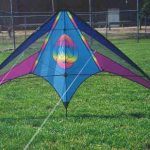 Pizazz Vented UL
Pizazz Vented UL
Manufacturer: Pizazz Kiteworks
Wingspan: 94.5 inches
Height: 46.5 inches
Wind Range: 4-20
Est. Street Price: $215
Pizazz Kiteworks is a one-man operation. All the kites are sewn and built by Dick Barnes. When you get a kite from a company like this you can tell a difference. The Pizazz is a kite that was designed for ballet style flying and competition.
The version that I reviewed is what Dick calls the Vented UL. It is framed light, so it will fly in lighter winds, but vented so it will handle higher winds. This kite is framed with Avia super Skinnies in the upper leading edge, Avia G-force UL in the spine, and SkyShark 3PT’s in the lower leading edge and lower spreaders.
The sail construction is where you mostly see the difference in a hand made kite. The Pizazz is made of a nine panel, ½ oz. Icarex, sail with two of the panels being vents in this version. The panels are held together with flat, rolled, finished off seams, which are all sewn very straight with every stitch in place. In the center panel there is an appliquéd design, which is sewn very cleanly and cut very smooth and straight. A strip of nylon is used on the trailing edge in place of a hem and a tension line runs though it. The Pizazz is not heavily reinforced. The nose is dacron and kevlar, and dacron is used at the standoff connection points on the sail. The T, tail, and leading edges are reinforced with ¾ oz. ripstop nylon. The fittings are tiny APA. There is a trick line, which is part of the line that tensions the wing tips, that minimizes knots. End caps cover all the nocks at the tips and tail so there are no knots exposed. This is a nice feature, which gives the kite a very clean look and minimizes wing wraps. Also, instead of C clips for stoppers on the leading edge, O rings are used. This is light and clean looking.
The bridle is a turbo/dynamic bridle constructed from Laser Pro black dacron line. For his own reasons, Dick does not mark the bridles. I find this makes it tough to make adjustments but that is my opinion. Dick says he may mark them in the future.
One cool thing extras that Dick sends with a Pizazz is a pack of business cards. These cards are unique though. They have a picture of your kite on them with its number and your name. There is also one of the cards secured in a transparent pocket on the bag of your kite. You can hand these cards out to people interested in the Pizazz. If they order one and say you’ve told them about the kite you get a recommendation. After ten recommendations you get a free kite. You can also trade the cards. This is a really cool idea and gives you the personal feel of owning a handcrafted kite.
For a vented kite the Vented UL Pizazz will fly in fairly light wind, needing only 4-5 mph of to fly. It will also handle the higher winds well. I flew it up to about 20 mph and it was fine. It will do smooth, crisp corners and it tracks solidly. It is easy to fly a straight line out of a spin as well. It was easy to stall the kite and hold it. Side slides were also very easy. With the vents, it was very easy to dump the wind out of the sail until you get up around 15 mph. It was also easy to do tip stabs with the Pizazz and the 3PT lower leading edges seemed to be very stiff and strong for this. Designed for ballet, it will fly very smooth figures with a moderate forward speed.
The Pizazz will also trick well. One of the things I really liked about it is that it doespiz4.JPG (24033 bytes) really flat axels and flat spins. It is really pretty to watch. Cascades are possible and fades are stable and will rise. If you let the nose rock back a bit while in a fade the kite will flip down out of the fade very nicely. The Pizazz does not want to recover off of its back though.
The Vented UL idea seems to work pretty well. It would be helpful to a competitor on a gusty day when you have to fly in moderate and high wind, with vents helping to smooth out gusts. The craftsmanship is topnotch. You do not get much better than this when it comes to sewing. The kite serves its purpose of being a ballet kite very well. With smooth corners, stable stalls, long slides, good stabs, and beautifully flat maneuvers, it would make it a bit easier to put together a winning routine.
Hunter Brown


